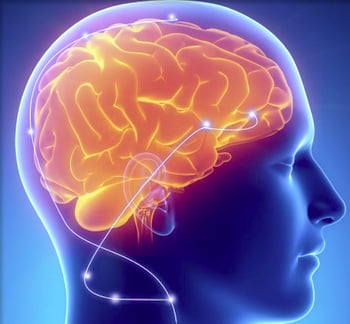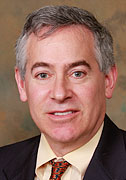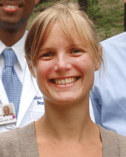 In an effort to better understand the reason that deep-brain-stimulation (DBS) seems to work so well in Parkinson’s cases, researchers at University of California, San Francisco have recently conducted NIH-funded research, with illuminating results.
In an effort to better understand the reason that deep-brain-stimulation (DBS) seems to work so well in Parkinson’s cases, researchers at University of California, San Francisco have recently conducted NIH-funded research, with illuminating results.
Deep brain stimulation (DBS) is a surgical procedure used to treat several disabling neurological symptoms—most commonly the debilitating motor symptoms of Parkinson’s disease, such as tremor, rigidity, stiffness, slowed movement, and walking problems, according to the National Institute of Neurological Disorders and Stroke (NINDS).
(image credit: https://www.michaeljfox.org)
In a DBS procedure, electrical impulses are sent along a wire into the brain, where they can block abnormal electrical signals and alleviate PD motor symptoms. Parkinson’s patients who receive DBS most often experience reduced symptoms of slow movement, tremor, and rigidity while the treatment is in effect.
Of the options for treatment of Parkinson’s disease, DBS is considered the most effective and rapid, and is widely utilized in the medical community. Prior to this bioresearch, however, little was understood about the exact mechanism that makes the treatment so effective.
In addition to nearly $.5M granted to UCSF researchers from the National Institutes of Health (NIH), the Michael J. Fox Foundation for Parkinson’s Research funded this study with an undisclosed sum in order for the medical community to learn more about the effectiveness of DBS.
According to a university press release, the researchers used recording electrodes in place during DBS treatments to learn exactly how DBS works. The researchers found that DBS keeps symptoms in check by reducing excessive synchronization of brain activity in the motor cortex, a region on the outer surface of the brain that governs movements of the body.
 During surgery on 23 patients with Parkinson’s disease in whom permanent DBS electrodes were being surgically implanted, the UCSF team slid a temporary strip of six recording electrodes under the skull and placed it over the motor cortex. As in prior research, recordings of neural activity showed excessive synchronization of activity rhythms in the patients.
During surgery on 23 patients with Parkinson’s disease in whom permanent DBS electrodes were being surgically implanted, the UCSF team slid a temporary strip of six recording electrodes under the skull and placed it over the motor cortex. As in prior research, recordings of neural activity showed excessive synchronization of activity rhythms in the patients.
“This therapy is becoming widespread for many brain disorders aside from movement disorders, including psychiatric conditions such as depression, but no one knows how it works,” said UCSF’s Philip Starr, MD, PhD, the Dolores Cakebread Chair in Neurological Surgery and senior author of the new study. “This is a significant step in answering this question on the level of brain networks, not just addressing where you’re actually applying the stimulation in the brain.”
 “Now we can try to find even better correlations between DBS and symptoms, and we can even look at the effects of medications,” said Coralie de Hemptinne, first author of the researchers’ paper published in Nature Neuroscience. “This new ability to collect data over a longer time course will be very powerful in driving new research.”
“Now we can try to find even better correlations between DBS and symptoms, and we can even look at the effects of medications,” said Coralie de Hemptinne, first author of the researchers’ paper published in Nature Neuroscience. “This new ability to collect data over a longer time course will be very powerful in driving new research.”
UCSF is the nation's leading university exclusively focused on health. In addition to its top status in health and medical research, UCSF is home to some of the busiest and most highly subsidized life science researchers in the world.
Key funding statistics from UCSF:
- Ranked #3 in NIH funding for 2014 with over $363 million
- The University of California, San Francisco is a $1 billion research market located within a $3 billion campus.
- UCSF has 4,000 employees, researchers, and students, as well as five Nobel Prize winners.
- A $1.52 billion complex, the new UCSF Medical Center at Mission Bay, is due to open its doors in 2015.
- Three health and medical sciences buildings are in the process of being renovated, costing up to $37 million.
- UCSF’s 2013 Life Science R & D Expenditures: $1,030,983,000.
As a leading life science research institution, UCSF is considered one of the largest markets in the world for the biotechnology industry.
 Biotech and lab supply vendors interested in promoting their products in this lucrative market will be attending the 24th Biotechnology Vendor Showcase™ Event at UC San Francisco, Parnassus campus on Wednesday, June 24th, 2015.
Biotech and lab supply vendors interested in promoting their products in this lucrative market will be attending the 24th Biotechnology Vendor Showcase™ Event at UC San Francisco, Parnassus campus on Wednesday, June 24th, 2015.
Last year, the UCSF Parnassus event attracted hundreds of research professionals, including professors, post-docs, purchasing agents and lab managers.
To learn more about participating in this premier event full of the latest biotech, lab supplies, and prominent life science professionals, click below:
Full schedule of 2015 Biotechnology Calendar, Inc. events:





